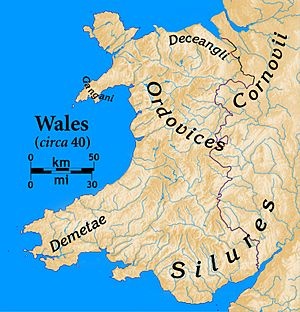Ordovices facts for kids
The Ordovices were a brave Celtic tribe who lived in Great Britain a long time ago. This was before the Romans came and took over. Their home was in what we now call North Wales and parts of England. They lived between two other tribes: the Silures in the south and the Deceangli to the north-east. While some tribes didn't fight the Romans much, the Ordovices were different. They fought back very strongly! A powerful Roman leader named Gnaeus Julius Agricola finally defeated them. This happened around 77–78 CE, when the Romans captured their last strongholds on Anglesey.
Contents
What's in a Name?
The name Ordovices might come from old Celtic words meaning 'hammer'. For example, in Welsh, the word for hammer is gordd. Some people think the name of this tribe is still found in a place called Dinas Dinorwig in North Wales. This name means "Fort of the Ordovices".
Geology Link: The Ordovician Period
Did you know a whole geological time period is named after the Ordovices? In 1879, a geologist named Charles Lapworth was studying rocks in North Wales. Since these rocks were found where the Ordovices used to live, he decided to name that time period the Ordovician period.
Where Did They Live?
The Ordovices lived in the western part of Britain. This was south of another tribe called the Brigantes. An ancient geographer named Ptolemy wrote about them. He said the Ordovices had two important cities: Branogenium and Mediolanium. We don't know exactly where these cities were located today.
The exact borders of their land are also a bit of a mystery. Some think their territory stretched into what is now the English Midlands. Others believe they mostly stayed north of the Dyfi and Dee rivers.
Fighting the Romans
The Ordovices were among the British tribes who strongly resisted the Roman invasion. At first, a famous Celtic leader named Caratacus helped them organize their fight. He had been exiled to their lands after his own tribe was defeated. Caratacus became a powerful warlord for the Ordovices and the nearby Silures. The Romans saw him as a major enemy.
In a big battle, the Roman governor Publius Ostorius Scapula defeated Caratacus. Caratacus was then sent to Rome as a prisoner.
The Ordovices' Last Stand
In the 70s CE, the Ordovices rebelled against the Roman soldiers who were occupying their land. They even destroyed a Roman cavalry group! This made the Roman governor Gnaeus Julius Agricola very angry.
According to an ancient writer named Tacitus, Agricola gathered his best soldiers. The Ordovices wouldn't come down to fight on flat ground, so Agricola led his troops up a hill to attack them. Tacitus wrote that the tribe was almost completely wiped out in this battle. After this victory, Agricola quickly went on to conquer Anglesey. We don't know the exact spot of this battle. However, a hill-fort called Dinas Dinorwig is a possible location.
See also
- List of Celtic tribes
- Prehistoric Wales


